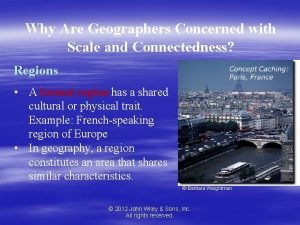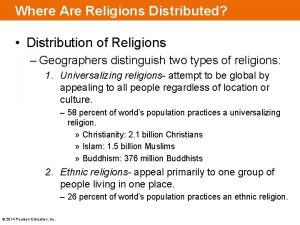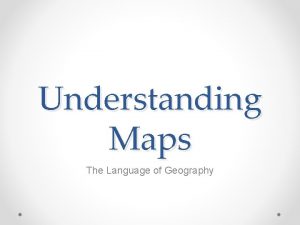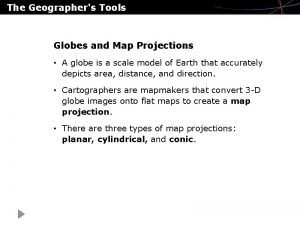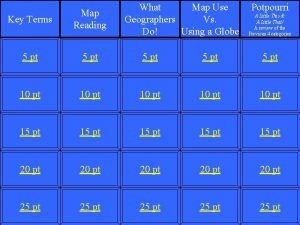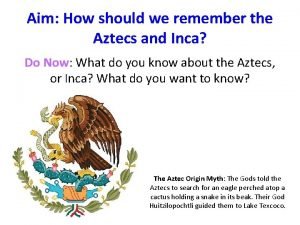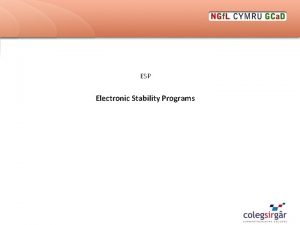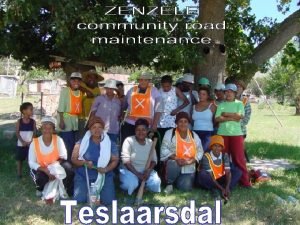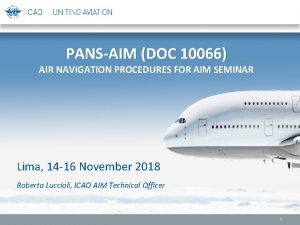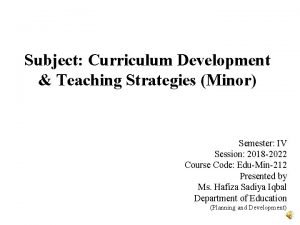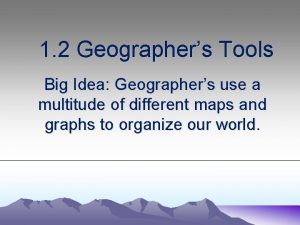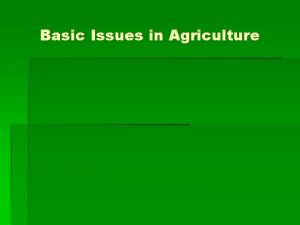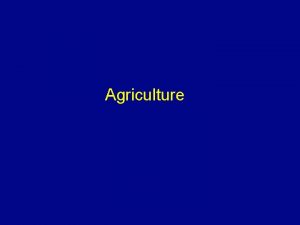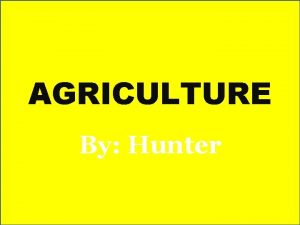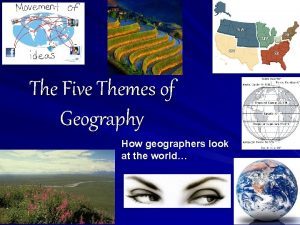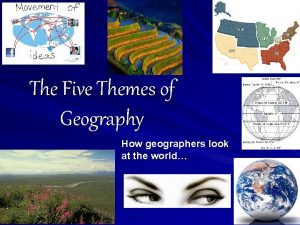AIM How do geographers look at agriculture Do




































- Slides: 36

AIM: How do geographers look at agriculture? Do Now: Draw a diagram showing how food travels from the farm to where it is sold.

So what? Agricultural investigation is concerned with economic, cultural, and biological relationships…

Agriculture “deliberate modification of the Earth’s surface through cultivation of plants and rearing of animals to obtain sustenance or economic gain. Agriculture thus originated when humans domesticated plants and animals for their use…”

A better definition “purposeful tending of crops and livestock. ” [H. H. Mc. Carty & J. B. Lindberg, A Preface to Economic Geography, (1966) p. 204.

An interesting issue Sugar In The Raw natural cane turbinado sugar is grown and cut exclusively in the tropics. There, nature's own sweetener is gently converted into the natural crystals that make Sugar In The Raw. – Sugar in the Raw Website In Jamaica, one can visit an active sugar plantation, and tour a museum made from an old plantation mansion.

One day, you visit this museum and then travel to a café a mile a way for lunch. Imagine sitting down at that café and ordering an unsweetened Iced Tea. You prefer it sweet but like having control over how sweet it is. How far do you think the sugar you used traveled in order to get from the plantation to your drink?


3154 Miles!!!

Steps in the Food System 1. Getting Ready to Grow Food 2. Growing the Food 3. Moving Food from the Field 4. Bring the food to a processing plant. 5. Process the food and sell it to a retailer. 6. Ship the food to the retailer. 7. Retailer restocks their shelves. 8. Customer buys food and brings it to where it will be consumed.

Agriculture & Rural Land Use – Key Topics Commercial Agriculture Subsistence Agriculture Primarily for purpose of selling products for money, often monocultures for economies of scale Primarily for direct consumption by a local population, usually small scale and low tech

Intensive Land Use Small-area farms or ranches High inputs of labor & high output per acre Cattle ranch, northeast Colorado Rice paddies, southeast China Extensive Land Use Large-area farms or ranches Low inputs of labor & low output per acre

Labor-Intensive Agriculture Large amount of human work is applied per unit of output Top picture – Labor-intensive corn raising in central Mexico. Bottom picture – Corn exported from capitalintensive U. S. farms to the Mexican market Capital-Intensive Agriculture Large amount of capital (equipment and buildings used to produce other goods) is applied per unit of output

Subsistence – predominantly lowincome regions Intensive subsistence – subtropical monsoon areas Shifting cultivation – tropical forests & savannas Nomadic herding – semiarid and arid lands Commercial – predominantly highincome regions Crop farming – more humid climates Livestock ranching - drylands

First Agricultural Revolution Invention of farming & domestication of livestock (8, 000– 14, 000 years ago) + diffusion from several source regions = shift from hunter-gatherer to agricultural societies Probable culture-hearths of agriculture

Second Agricultural Revolution Technological changes (starting 1600 s in Western Europe; spread by 1800 s to North America) Began with new methods: crop rotation, better horse collars Later innovations: replace human labor with machines, supplement natural fertilizers & pesticides with chemical Beginnings of commercialization of agriculture (production of surplus for trade); enabled widespread urbanization

Is Farming worth it? Read; “The Worst Mistake in the History of the Human Race” By Jared Diamond 1. What is the “progressivst view” 2. What are 3 pieces of evidence that farming has actually hurt us? 3. How much time do Bushmen spend foraging for food?

Bushmen of the Kalahari

Sustainable Agriculture Sustainable agriculture integrates three main goals: environmental stewardship, farm profitability, and prosperous farming communities. Farmers who own work in sustainable agriculture try to limit their carbon footprint, recycle crop waste, and sell their crop at local markets.

AIM: How do farming practices vary around the world? Do Now: Copy the Vocabulary Sustainable agriculture integrates three main goals: environmental stewardship, farm profitability, and prosperous farming communities. Farmers who own work in sustainable agriculture try to limit their carbon footprint, recycle crop waste, and sell their crop at local markets.

Read the Article: “How far does food travel to get to your plate? ” Answer questions 1 -5 on the handout.

Awesome Vocabulary Acre: An acre is a measurement of land. One acre comprises 4, 840 square yards or 43, 560 square feet. A square that is 208 feet and 9 inches long on each side could surround an acre. There are 640 acres in each square mile

How different would life in the USA have been if 40 acres and a mule had happened?

40 acres and a mule All freed slaves were supposed to receive 40 acres and a mule after the Civil War as a way to get a “leg up” on starting a life as a free person. How many soccer fields would that equal?

Geographers look at Agriculture in different ways Subsistence or commercial – (most important differentiation) Nomadic or sedentary Diversified or specialized Extensive or intensive This is how Professor Glasgow viewed agriculture.

Awesome Vocabulary Hectare: a hectare is a metric area measurement. It is 100 meters (109. 36 yards) by 100 meters.

When and where did agriculture originate?

The Neolithic Revolution 10, 000 -6, 000 years ago The earliest hearth was the Fertile Crescent in Southwest Asia.

Types of Cultivation Vegetative Planting – cutting, cloning and dividing roots (As an aside the apples we eat are from two trees. There is the tree that provides the root system and the trunk. The branches from which the fruit is obtained are from cuttings from other trees. The fruit thus born comes from two trees. Why? Fruit from trees grown from seeds are not very palatable. The combining of the fruit from two trees makes them worth eating. )

How grafting works

Wild Banana vs. Edible Banana

Question Agricultural Hearths. The first vegetative plantings were probably from SE Asia. Why? “The practice originated primarily in Southeast Asia according to Carl Sauer. Two other early centers of vegetative planting were in West Africa and in northwestern South America. From these hearths, the practice diffused to other regions. ”

Explanation Primary food was via fishing which allows for a more sedentary lifestyle.

Seed agriculture. First seed agriculture probably had 3 hearths, Western India, north China & Ethiopia. “That agriculture had multiple origins means that, from earliest times, people have produced food in distinctive ways in different regions. This diversity derives from a unique legacy of wild plants, climatic conditions, and multiple preferences in each region. ”

Classifying Agricultural Regions There are fundamental differences between agriculture in LDCs, where production is fundamentally for their own consumption, with MDCs, where much of the produce is sold. % of Farmers in Work Force: LDC’s c. 50% while MDC’s <10%. Differences in the use of machinery Differences in Farm Size

How do agricultural regions originate? The crop chosen is a result of a variety of factors: environmental, practical and psychological. Every region is unique and has its own reasons for their existence of their crops. The process of developing into recognizable regions are however similar.

How are animals domesticated?
 Look left right
Look left right Perceptual region
Perceptual region How geographers look at the world worksheet answers
How geographers look at the world worksheet answers Why are geographers concerned with scale and connectedness
Why are geographers concerned with scale and connectedness Why do geographers use population pyramids
Why do geographers use population pyramids What was the nomadic lifestyle
What was the nomadic lifestyle Why do geographers study religion
Why do geographers study religion What map is this
What map is this Why are geographers concerned with scale and connectedness?
Why are geographers concerned with scale and connectedness? Geographers tools
Geographers tools Geographers tools
Geographers tools What basic questions guide geographers
What basic questions guide geographers Activity 1 picture
Activity 1 picture Activity 1 a) look at the picture
Activity 1 a) look at the picture Activity 1 look up look down
Activity 1 look up look down Simplify fractional exponents
Simplify fractional exponents Aim 45
Aim 45 Maya and aztec similarities
Maya and aztec similarities G3nrw
G3nrw Aim aztec
Aim aztec That is not all technique
That is not all technique Aim who
Aim who Adjectives for aim
Adjectives for aim Kno3 salt bridge
Kno3 salt bridge What is fixation of tissue
What is fixation of tissue Osu slds aim
Osu slds aim Esp objectives
Esp objectives Potassium lithium
Potassium lithium Aim in psychology
Aim in psychology Spartan aim
Spartan aim Aim road maintenance
Aim road maintenance Mad gabs example
Mad gabs example Aim what
Aim what Mit linguistics
Mit linguistics Aim of filtration
Aim of filtration Doc 10066 icao
Doc 10066 icao Importance of curriculum
Importance of curriculum



